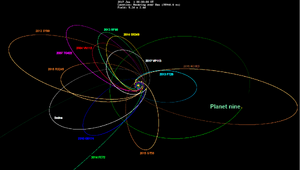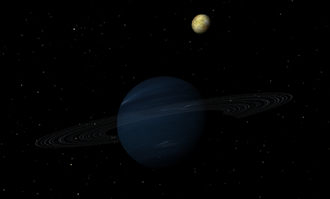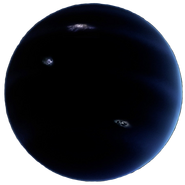No edit summary Tag: Visual edit |
(Adding categories) |
||
| Line 28: | Line 28: | ||
[[Category:Gaseous Planets]] |
[[Category:Gaseous Planets]] |
||
[[Category:Good Characters]] |
[[Category:Good Characters]] |
||
| + | [[Category:Universe Size Comparison]] |
||
Revision as of 16:58, 23 October 2021

The orbit of 2015 KG163 (right side, in orange) and other extreme detached objects, along with the hypothetical Planet Nine's orbit on the right
Planet Nine, or Planet X, is a hypothetical planet hypothesized to exist in the outermost edges of the Solar System, possibly in the Oort Cloud.
It is thought to be about 42,000 kilometers in diameter, probably larger than Earth but smaller than Neptune. Many official names have been suggested for Planet Nine, like Ophadamia and Erebus.
It is probably composed of the same materials as the ice giants, like hydrogen, helium, methane, water, and ammonia. It is also likely to have a simple ring system similar to that of Neptune's. Because of its distance from the Sun, it is hypothesized that a year on Planet Nine would take around 20,000 years!
Origins
It is still unclear how Planet Nine could have gotten into the outer Solar System.
Many theories suggest that Planet Nine could've been ejected into the Oort Cloud during the rapid migration of Neptune and the ejection of the Fifth Giant, while others suggest that Planet Nine could be a rogue exoplanet that was captured by the Sun in the past.
Evidence
Recently, scientists observed clustering of objects beyond Neptune's orbit, and that something large was affecting their stability.
This led to the theory of a ninth planet existing in the outermost edges of the Kuiper Belt, but no such planet was found.
Later, scientists theorized that Planet Nine could be a black hole. But this theory isn't widely accepted.

